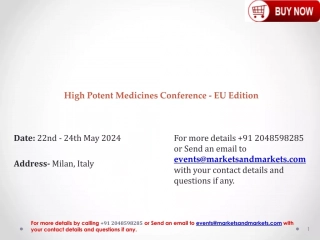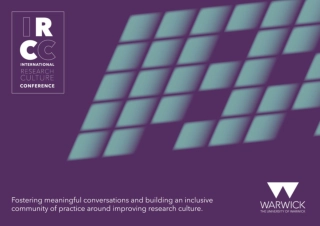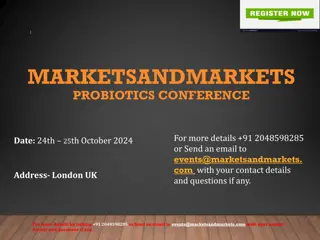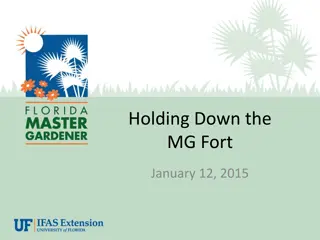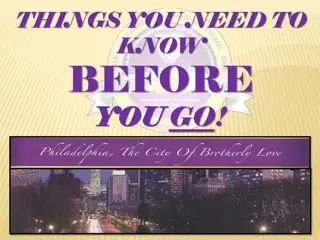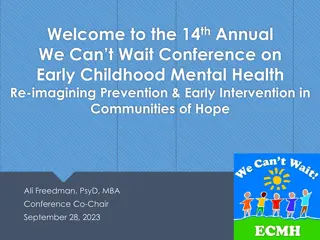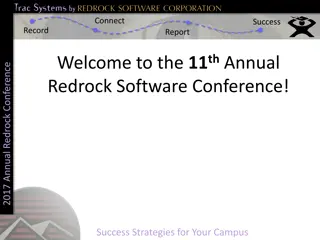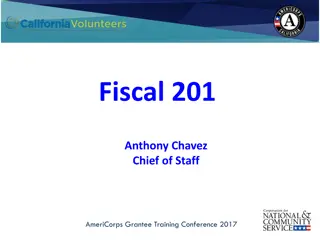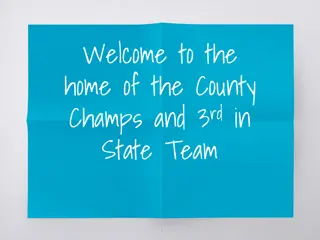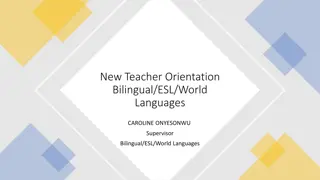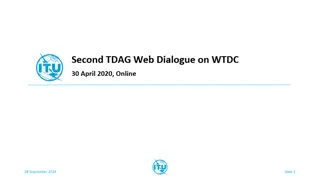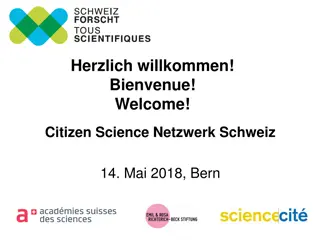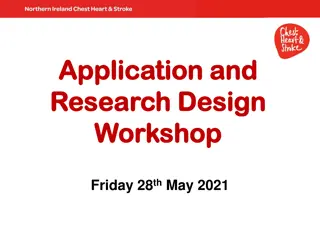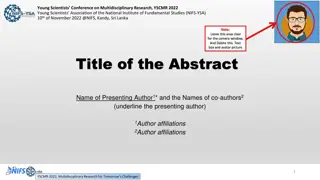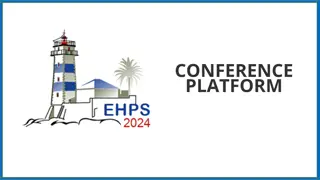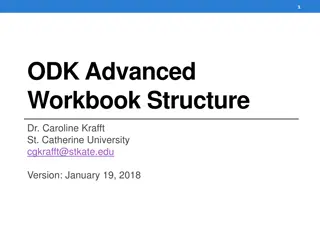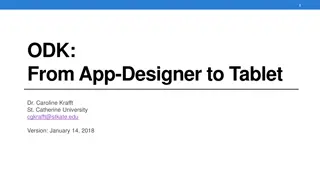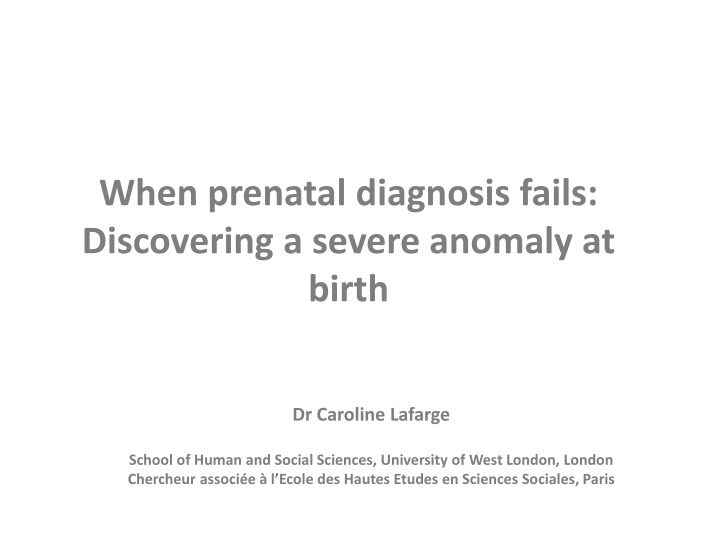
Exploring Women's Experiences When Severe Anomaly Discovered at Birth
Discover the intricate journey of women who face the unexpected challenge of a severe anomaly being discovered at birth, delving into their emotional responses and coping mechanisms. This in-depth research sheds light on the complexities of motherhood amidst crisis situations.
Download Presentation

Please find below an Image/Link to download the presentation.
The content on the website is provided AS IS for your information and personal use only. It may not be sold, licensed, or shared on other websites without obtaining consent from the author. If you encounter any issues during the download, it is possible that the publisher has removed the file from their server.
You are allowed to download the files provided on this website for personal or commercial use, subject to the condition that they are used lawfully. All files are the property of their respective owners.
The content on the website is provided AS IS for your information and personal use only. It may not be sold, licensed, or shared on other websites without obtaining consent from the author.
E N D
Presentation Transcript
When prenatal diagnosis fails: Discovering a severe anomaly at birth Dr Caroline Lafarge School of Human and Social Sciences, University of West London, London Chercheur associ e l Ecole des Hautes Etudes en Sciences Sociales, Paris
Content Introduction Objective Method Results Conclusions
Introduction o ANR & PICRI studies on professional practice and women s experiences of prenatal diagnosis o International studies comprising sociologist, psychologist, medical and legal historians, philosophers o 2012-2017 o Today women s experiences of prenatal diagnosis in France
Introduction o Prenatal diagnosis in France: 3 ultrasounds (12, 22 & 32 SA) Down s syndrome screening: 87% uptake; 74% for combined testing (HAS, 2017) Still 2.5% (21,000/year) of babies born with congenital anomaly (InVS, 2015).
Research background Discovering a severe anomaly at birth o Series of crises (Kandel & Merrick, 2007) Of the individuals Evolution of individuals values (ambivalence) Daily management o Complex transition to motherhood (Van Wyk & Leech, 2016) Internal world External world The in-between
Objective To explore women s experiences when a severe anomaly is discovered at birth
Methods o Etude PICRI women s experience of prenatal diagnosis o Quantitative: 1566 responses with 585 agreeing to be re-contacted o Qualitative: 95 contacted for an interview 64 interviews conducted 8 with women who discovered a severe anomaly at birth o Data analysed using Interpretative Phenomenological Analysis (Smith, 1996)
Participants Age Nb children / Pregnancy 33 2, 2ndPregnancy Screening Anomaly Possible to detect in utero No Issue grossesse Camille Combined test: negative Gene CDKL5 deletion Child severely disabled (diagnosed at 6 months) Catherine 29 1 Nuchal translucency: negative Down s syndrome (diagnosed at birth) Yes Down s syndrome but no major co- morbidities Julie 35 2, 2ndPregnancy Combined test: negative Craniofacial malformations (diagnosed at birth) Yes Surgery performed at 10 months; other surgeries planned Mathilde 33 2, 2ndPregnancy Combined test: negative Streptocoque B: negative Infection Streptocoque B (diagnosed Day 5) Yes Intensive care, reanimation for 6 weeks; risk of cognitive delay No mie 32 1 Combined test: negative Cardiac anomalies Yes Surgery performed at 9 days, follow up for life. May need other surgical interventions Down s syndrome but no major co- morbidities (diagnosed at birth) Sarah 34 1 Combined test: negative Down s syndrome Yes (diagnosed at birth) Ariane 35 3, 2ndPregnancy Combined test: negative Trisomy 13 Yes Palliative care Deceased 8 days (diagnosed at birth) Lise 41 2, 4th Pregnancy Combined test: negative Oesophagus atresy Yes Surgery at birth, palliative care and deceased at 30 days (diagnosed at birth)
Findings A new narrative Internal earthquake Action against powerlessness Complex relationship with health professionals Entering the new world of disability
Person-dependent Complex relationship with health professionals Doctor/patient dynamic Post-rationalisation Bitterness but no direct accusation
Person-dependent A faultless support Everyone, from the doctors to the midwives, to the assistants, really everyone was very, very good to us. I saw the medical profession from a different angle. I actually think that these people are devoted body and soul. (Julie, craniofacial malformations) Health professionals as guides I knew nothing about babies, I didn t know how they worked . So there, at the hospital, I had plenty of nurses to explain how it worked. It was very good! (Catherine, Down s syndrome)
Person-dependent Information & communication to be improved I cruelly lacked information. (...) He said to us 'there is certainly a problem with the heart but I am not specialised in pediatrics'. But he knew. He knew because after we were transferred, the cardio paediatrician told us: 'There is this problem and that problem and so Mr X correctly diagnosed that there is a problem. (No mie, cardiac anomalies) Zero information from start to finish (...) Finally I was what? A number that gave birth that had a problem after. (No mie, cardiac anomalies) The midwife had just stitched me up. In fact, she was sewing me up while he was looking at my baby. I still had my feet in the stirrups! She put the baby on me and, then, there is the gentleman who comes: "well then, we suspect a trisomy 21. (Sarah, Down s syndrome) Lack of consideration & empathy
Doctor/patients dynamic Deference to health professionals I was not going to tell her what she had to do (Ariane, Trisomy 13) Inverted roles? Attachment The professionals around us do not know much about the disease. For those who accept to learn things from parents, it s rather we who bring something to them than the opposite. (Camille, CDKL5 deletion) Me, I still feel connected and my husband too, anyway. I still feel a strong connection with the [medical] team. (Lise, Charge syndrome)
Bitterness, but no direct accusation We all make mistakes He s not a god, he s not a robot (...) I.. I sometime mess up in my job. He is not a god (Lise, Charge syndrome) The threat of litigation I think there are also doctors who are a little freaked out and who say to themselves: my god, we did not see the first trisomy, we are going to be taken to court. And it's not in our culture! But I guess it must happen. So, I was followed more for that reason than anything else. (Catherine, Down s syndrome)
Bitterness but no direct accusation Technology & expertise questioned Condition-specific My sisters-in-law have had their ultrasounds in Paris, it seems that they are much more detailed there... So then, maybe we need to revise doctors' training, I don t know. I don t know how it works. There may be some training courses for gynaecologists and maybe there are things that need to be changed. Then again, there are also the ultrasound machines [to think about]. (Ariane, Trisomy 13) Charge Syndrome from what I ve understood it is sonographers pet hate because it is very difficult to detect in- utero. (Lise, Charge syndrome ) Health professionals soul searching She called me three times after the birth. She called me almost every fortnight to find out how I was doing. We could see very well that she was felling guilty. (...) Afterwards, we saw her early April for the postnatal visit. She stayed with us for over an hour and we could see she had tears in her eyes. I think it has led her to question ... It is someone who is serious and this has led her to question her entire work, I think .. (Ariane, Trisomy 13)
Post-rationalisation I prefer to have had it this way, because to have known before, I think I would not have had a good experience of my pregnancy; whereas I had a perfect pregnancy, a perfect delivery. Everything was very, very good. (No mie, cardiac anomalies) Ignorance is bliss The outcome would have been the same If there is nothing at the combined test, that everything is good at the combined test, this means that there is nothing to worry. Having said that, it would not necessarily have changed much because I don t think I would ... I do not even know whether I would even have done the amniocentesis because I think I would have been too afraid to lose him ! In any case, the outcome would have been the same (Sarah, Down s syndrome) Avoiding difficult questions It was not diagnosed. If it had been, I don t want to think about what I would have done if it had been diagnosed, what would we have been done because it would have been me and my husband. There I don t want to think about that. (Julie, craniofacial malformations)
Post-rationalisation My husband had been to see a psychologist after this tragedy. The psychologist told him that in all this unfortunate story, one had to get out something positive. And we, we got some positive out of it we have known him alive. I gave birth to a child who was alive sand we had him for 8 days, alive and in our arms. So, we got something positive out of all of it. (Ariane, Trisomy 13) Filial bond I am not going to say that disability is great and that we re in Tellitubies land! Far from it. But it brings other things. It made me grow and look at life differently. (Camille, CDKL5 deletion) Posttraumatic growth I wanted for a long time to do something else in my life than to work-and-dodo-family do something to be a little more useful to the community ... I think that at some point I will re-contact the Charge Association. I need to be useful, to tell myself that if this experience can be useful to other parents, to help them though a difficult time, all is not completely lost (...) something good needs to come out of this and not just for us. (Julie, Charge syndrome)
Conclusions The discovery of a severe anomaly at birth represents an important challenge for women, o leading to significant changes to their sense of self It also signals a brutal transition to a world of difference , permanently alters the family o narrative, and impacts upon the way women anticipate the future It also triggers general reflexions on the practice/malpractice of prenatal diagnosis o Our study findings indicate that when women are confronted with this new situation, they o develop strategies enabling them to adapt to, and to some degree, accept their predicament whilst regaining a certain degree of control over the situation Women s relationships to professionals are complex and ambivalent but also encompass o feelings of loyalty and attachment Despite the initial trauma of finding out about the anomaly, women are grateful at the o opportunity to know their baby
Conclusions Women share with professionals some life-defining moments and it is health o professionals ability to respond to women s emotional needs more than their technical competence that matter to women. Despite the fact that health professionals have failed to detect the anomaly in utero o women tend to remain loyal to the medical team and develop various strategies to accept their situation and even derive some benefits from it.
Thank you for your attention! Questions?

